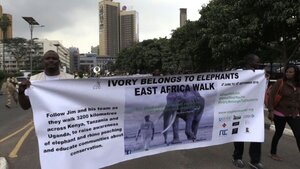South Sudan ivory seizure highlights Africa's 'ongoing poaching crisis'
Authorities seized more than a ton of ivory at the Juba airport showing the ivory trade is still rampant despite ongoing international efforts to crush it.

Kenyan conservationists welcome the move by the United States on Thursday of a near-total ban on the trade of African elephant ivory, finalizing a years-long push to fight the poaching of the threatened animals.
The seizure of more than one ton of ivory at a South Sudanese airport highlights the scale of Africa’s poaching crisis, conservationists say.
Authorities discovered a batch of containers labelled “food,” but filled with ivory, on an Ethiopian flight from Uganda that arrived in the nation’s capital, Juba, on Friday. It was planned to be transferred to an EgyptAir flight bound for Malaysia.
Brig. Gen. Khamis Adieng Ding, spokesperson for the National Wildlife Service, said one Ugandan and a South Sudanese had been taken into custody in connection with the shipment.
The World Wildlife Fund’s (WWF) Lamine Sebogo said the seizure "is a reminder of the scale of the ongoing poaching crisis" in Africa.
Indeed, the latest seizure comes only a month and a half after Kenya sent a strong message to ivory traders when it burned what is believed to be the biggest ever stockpile of ivory every destroyed – 105 tons from more than 6,000 elephants and around 450 rhinos. An estimated 30,000 elephants are slaughtered every year for their ivory.
Kenya’s Daniel Arap Moi started the practice with the first ivory burn in 1989. Other countries have since followed suit with publicized crushings and burnings of varying proportions.
The effectiveness of destroying ivory stockpiles to deter poachers is still debated, but it is broadly accepted as better than previous alternatives.
For example, in 2008 the ban on the sale of ivory was temporarily lifted so governments that owned seized ivory stockpiles could sell them for profits, on the condition they would be channelled into conservation efforts. However, according to conservationists, such moves have led to a spike in demand and therefore in poaching whenever it has been trialled.
Around 100,000 elephants were killed following the temporary lifting of the 2008 ban, which allowed China, home to the biggest black market for ivory, to buy much of the ivory, according to The Guardian.
US Fish and Wildlife Service responded earlier this month to what it called the “alarming” rise of poaching, particularly of the African elephant, by placing a “nearly complete” ban of commercial ivory trading within the country.
"Up until now, ivory markets in the US have pretty much had free run. It was very hard to prosecute people for selling ivory because the exceptions and loopholes were so large,” Jeff Flocken, North American regional director for the International Fund for Animal Welfare, told The Christian Science Monitor at the time.
"The rule ... really takes a hard look at what is legal and what isn't, and as the US government said, it's a near ban," Mr. Flocken said.
This report contains material from the Associated Press.

